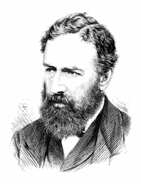W. Stanley Jevons
Born 1835, Liverpool, England; drowned while swimming, 1882, Bulverhythe (near Hastings), England, inventor of an early logic machine, and a pioneer in the application of statistical techniques to economic questions.

Education: MA, University College, London, 1859.
Professional Experience: British Mint, Sydney, Australia, 1854-1859; Owens College, Manchester: tutor, 1859-1861, professor of logic and mental and moral philosophy, 1861-1876; professor of political economy, University of London, 1876-1880.
Honors and Awards: LLD, University of Edinburgh; fellow of the Royal Society.
As an economist, Jevons is regarded as one of the pioneers in the rigorous applications of statistical techniques to the study of economic issues. His Theory of Political Economy (1871) is the most important of his many books and papers on economic and political issues. Unfortunately his valuable contributions to economic theory (especially his trenchant analysis of marginal utility) are less well remembered today than his speculations on the relation of sunspots to business cycles. In the light of present-day knowledge and statistical sophistication, such a theory can only be regarded as eccentric, but we must remember that in Jevons' time it was far from a "crank" notion. The view that sunspots might influence weather and crops, which in turn would affect the business cycle, then had a plausibility that deserved careful exploration.
In a somewhat similar fashion, Jevons' fame as the inventor of a logic machine has tended to obscure the important role he played in the history of both deductive and inductive logic. He was one of the pioneers of modern symbolic logic, and his Principles of Science, first issued in 1874, deserves far more recognition than it has today, as an important treatise on the philosophy and methods of science. At a time when most British logicians ignored or damned with faint praise the remarkable achievements of George Boole, Jevons was quick to see the importance of Boole's work as well as many of its defects. Jevons believed that Boole had been led astray by efforts to make his logical notation resemble algebraic notation. He also saw clearly the weakness in Boole's preference for the exclusive rather than the inclusive interpretation of "or." Jevons devised a method of his own that he called the "method of indirect inference." The system is very similar to Venn's diagrammatic method as well as a primitive form of a truth table.
Jevons' "logical abacus" was a labor-saving device that required only the addition of keys, levers, and pulleys to become a logic machine. The abacus consisted of small rectangular wooden boards, all the same size and each bearing a different combination of true and false terms. The boards were lined up in a rack. An arrangement of pegs on the side of each board was such that one could insert a ruler under the pegs and quickly peg out whatever group of boards one wished to remove from the rack.
Jevons' "logical piano" was built in 1869. In appearance the machine resembles a miniature upright piano. On the face of the piano are openings through which one can see letters representing the 16 possible combinations of four logical terms and their negatives. The keys at the bottom are used to introduce the terms of a logical equation. This action automatically eliminates from the face of the machine all combinations of terms which are inconsistent with the proposition just fed to the machine. After all premises have been fed to the device, its face is then examined to determine what conclusions can be drawn. [Drawn from Gardner, 1958.]
QUOTATION
"I am quite convinced that Boole's forms ... have no real analogy to the similar mathematical expressions."
BIBLIOGRAPHY
Biographical
Gardner, Martin, Logic Machines and Diagram, McGraw-Hill Book Co., New York, 1958, Chapter 5.
Significant Publications
Jevons, W. Stanley, Pure Logic and Other Minor Works, MacMillan and Co., London, 1890. [Published posthumously; edited by Robert Adamson, professor of logic at Owens College, and Harriet A. Jevons.]
UPDATES
Portrait added (MRW, 2013)
New content Copyright © 2013-2023 by the IEEE Computer Society and the Institute of Electrical and Electronics Engineers Inc.
All rights reserved. This material may not be reproduced or redistributed without the express written permission of the copyright holder.
